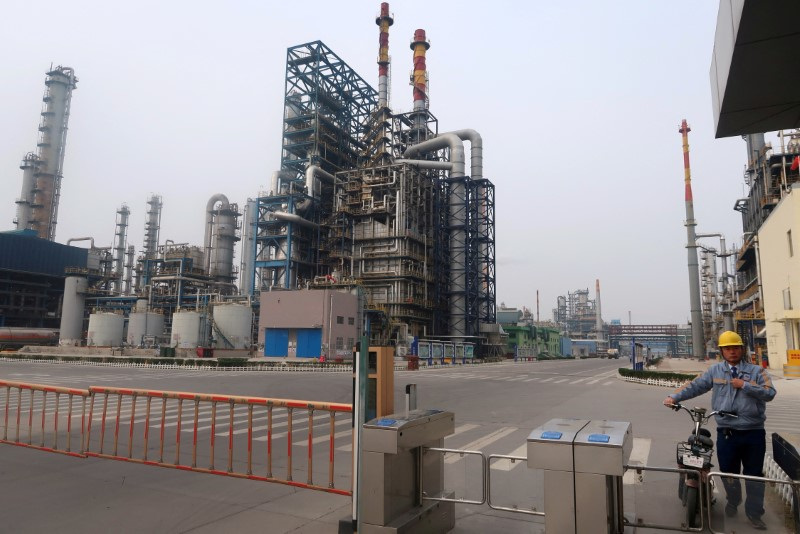By Mohi Narayan and Joyce Lee
NEW DELHI/SEOUL (Reuters) – Petrochemical makers in Europe and Asia are in survival mode as years of capacity building in China’s top market and high energy costs in Europe have squeezed margins for two years in a row, forcing companies to consolidate.
The sector’s weakness is worrying for a global oil industry that uses petrochemicals to lock in profits as demand for transportation fuels falls in coming years due to the energy transition.
Major producers in Asia and Europe are selling assets, closing older plants and adapting facilities to use cheaper feedstocks such as ethane instead of naphtha to reduce costs, industry executives and analysts say.
Producers will need to further consolidate ethylene and propylene capacity as oversupply is expected to persist for years and new plants continue to come online in the Middle East and China even as the Chinese economy struggles.
Ethylene and propylene, produced from petroleum products, are basic raw materials for making plastics, industrial chemicals and pharmaceuticals that are widely used in everyday life.
Consultancy Wood Mackenzie estimates that around 24% of global petrochemical capacity is at risk of permanent closure by 2028, amid weak margins.
“We expect rationalization in Europe and Asia to continue in this cycle,” said Eren Cetinkaya, partner at McKinsey & Company. He expects the current downturn to last longer than the usual five to seven years due to long-term capacity building, especially in China.
Asian producers face the toughest outlook, with oversupply likely to persist as some companies are unlikely to curtail production in new units and factories integrated with wider operations.
“Since 2022, however, a range of factors have made the business environment more difficult – including declining domestic demand and drastic oversupply due to new production facilities launched in China and other parts of Asia,” Mitsui Chemicals said in a report. statement in April.
Propylene production margins in Asia are expected to end up in the red this year, with losses expected to average about $20 per tonne, according to consultancy Wood Mackenzie.
In Europe, profit margins are expected to rise from last year to almost $300 per tonne in 2024, but that is 30% lower than two years ago.
In contrast, U.S. propylene margins are expected to rise 25% to about $450 per tonne by 2024. U.S. producers are shielded from the margin crunch by an abundant supply of domestic feedstock from cheaper liquids such as ethane, said WoodMac analyst Kai Sen Chong.
ASIA PRODUCERS SEARCH FOR NEW MARKETS
In Asia, Taiwan’s Formosa Petrochemical has closed two of its three naphtha crackers for a year, while Malaysia’s PRefChem, a partnership between Petronas and Saudi Aramco (TADAWUL:), has kept his cracker closed since earlier this year.
However, producers in South Korea and Malaysia are keeping production rates high despite losses because their plants are integrated with oil refineries. That leaves them unable to close or sell loss-making petchem units without impacting production of other products, industry sources said.
“Most companies’ portfolios are integrated and balanced. To consolidate them, you either have to destroy the strengths of one company or lose the strengths of the other,” said an official at a major South Korean state-owned company. the refinery said.
“But I don’t think it will be easy for Korean companies to do this without clear profits,” said the official, who spoke on condition of anonymity.
As production and exports from the Middle East, China and the US grow, companies are exploring growth markets such as India, Indonesia and Vietnam to sell their excess supply.
Fewer capacity additions and growing demand for polymers and chemicals would make India one of the most attractive markets in the world, Navanit Narayan, CEO of India’s Haldia Petrochemicals, told Reuters.
In addition to finding new outlets, Japanese and South Korean petrochemical makers are exploring niche projects to boost margins by producing low-carbon and recyclable plastics that could command higher prices as demand for greener products grows.
Mitsubishi Corp is working with Finland’s Neste to develop renewable chemicals and plastics. Sumitomo Chemical aims to make products using polymethylmethacrylate recycling technology to create plastics that contain less carbon than traditional products.
THE CONSOLIDATION OF EUROPE IS INCREASED
Consolidation is underway in Europe, where Saudi Arabian Basic Industries Corp (SABIC) and ExxonMobil Corp (NYSE:) has announced plans to permanently close some factories due to high costs.
SABIC is also adapting facilities in Europe and Britain to process more ethane, which is cheaper than naphtha, Olivier Gerard Thorel, SABIC’s executive vice president of chemicals, told Reuters in May.
Ethane, which is priced relative to natural gas, is generally cheaper than naphtha produced from oil. SABIC owns flexible feed crackers that can use naphtha, ethane and liquefied petroleum gas (LPG) as feedstocks.
WoodMac’s Chong said the shift is mainly driven by high energy and manufacturing costs and poor demand in the region, amid weak economic growth in recent years.
Houston-based giant LyondellBasell sold its U.S. ethylene oxide and derivatives business in May.

In Europe, the company said it was exploring all options when asked by Reuters whether it plans to exit the petrochemical business in the near term.
“Market conditions in Europe are expected to be challenging in the long term,” a company spokesperson said.





















